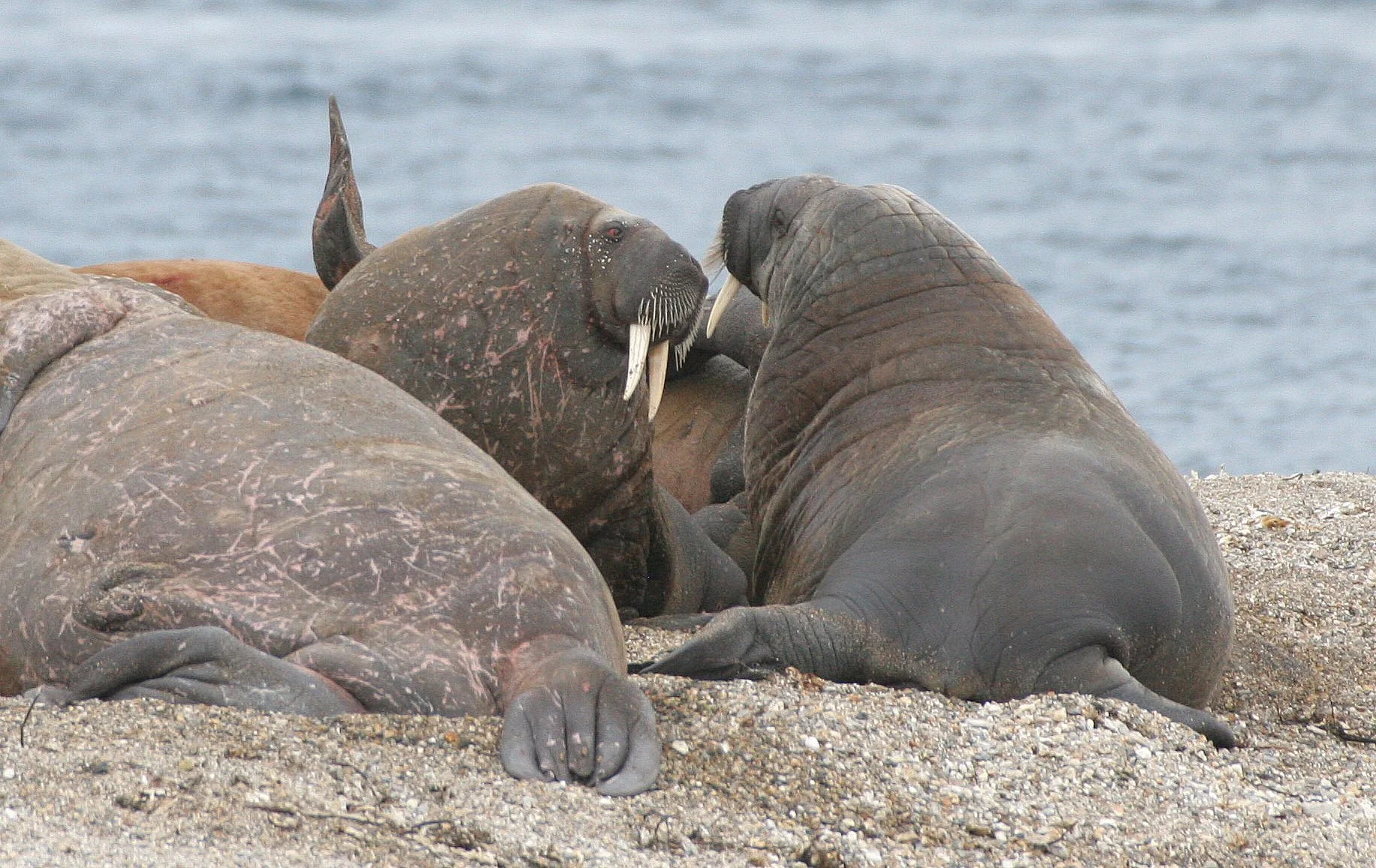The walrus (Odobenus rosmarus) is a large flippered marine mammal with a discontinuous distribution about the North Pole in the Arctic Ocean and subarctic seas of the Northern Hemisphere. The walrus is the only living species in the family Odobenidae and genus Odobenus. This species is subdivided into two subspecies: the Atlantic walrus (O. r. rosmarus), which lives in the Atlantic Ocean, and the Pacific walrus (O. r. divergens), which lives in the Pacific Ocean.
Adult walrus are characterised by prominent tusks and whiskers, and their considerable bulk: adult males in the Pacific can weigh more than 2,000 kilograms (4,400 pounds) and, among pinnipeds, are exceeded in size only by the two species of elephant seals. Walruses live mostly in shallow waters above the continental shelves, spending significant amounts of their lives on the sea ice looking for benthic bivalve mollusks to eat. Walruses are relatively long-lived, social animals, and they are considered to be a "keystone species" in the Arctic marine regions. The majority of the population of the Pacific walrus spends its summers north of the Bering Strait in the Chukchi Sea of the Arctic Ocean along the northern coast of eastern Siberia, around Wrangel Island, in the Beaufort Sea along the northern shore of Alaska south to Unimak Island, and in the waters between those locations. Smaller numbers of males summer in the Gulf of Anadyr on the southern coast of the Siberian Chukchi Peninsula, and in Bristol Bay off the southern coast of Alaska, west of the Alaska Peninsula. In the spring and fall, walruses congregate throughout the Bering Strait, reaching from the western coast of Alaska to the Gulf of Anadyr. They winter over in the Bering Sea along the eastern coast of Siberia south to the northern part of the Kamchatka Peninsula, and along the southern coast of Alaska.[4] A 28,000-year-old fossil walrus was dredged up from the bottom of San Francisco Bay, indicating that Pacific walruses ranged that far south during the last Ice Age.
Commercial harvesting reduced the population of the Pacific walrus to between 50,000 and 100,000 in the 1950s-1960s. Limits on commercial hunting allowed the population to increase to a peak in the 1970s-1980s, but subsequently, walrus numbers have again declined. Early aerial censuses of Pacific walrus conducted at five-year intervals between 1975 and 1985 estimated populations of above 220,000 in each of the three surveys.
In 2006, the population of the Pacific walrus was estimated to be around 129,000 on the basis of an aerial census combined with satellite tracking. There were roughly 200,000 Pacific walruses in 1990.
The much smaller population of Atlantic walruses ranges from the Canadian Arctic, across Greenland, Svalbard, and the western part of Arctic Russia. There are eight hypothetical subpopulations of Atlantic walruses, based largely on their geographical distribution and movements: five west of Greenland and three east of Greenland. The Atlantic walrus once ranged south to Sable Island, Nova Scotia, and as late as the 18th century was found in large numbers in the Greater Gulf of St. Lawrence region, sometimes in colonies of up to 7,000 to 8,000 individuals. This population was nearly eradicated by commercial harvest; their current numbers, though difficult to estimate, probably remain below 20,000. In April 2006, the Canadian Species at Risk Act listed the population of the northwestern Atlantic walrus in Quebec, New Brunswick, Nova Scotia, Newfoundland and Labrador as having been eradicated in Canada. A genetically distinct population existed in Iceland that was wiped out after Norse settlement around 1213–1330 AD.
The isolated population of Laptev Sea walruses is confined year-round to the central and western regions of the Laptev Sea, the eastmost regions of the Kara Sea, and the westmost regions of the East Siberian Sea. The current population of these walruses has been estimated to be between 5,000 and 10,000.
Even though walruses can dive to depths beyond 500 meters, they spend most of their time in shallow waters (and the nearby ice floes) hunting for food.
The individuals in this gallery were photographed in Svalbard.



























































































































































































































































































































